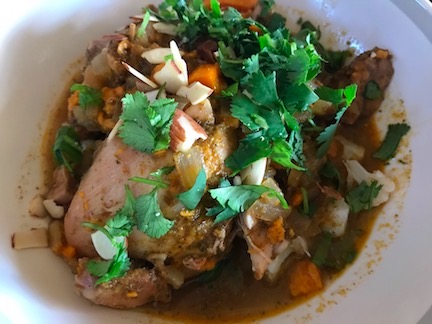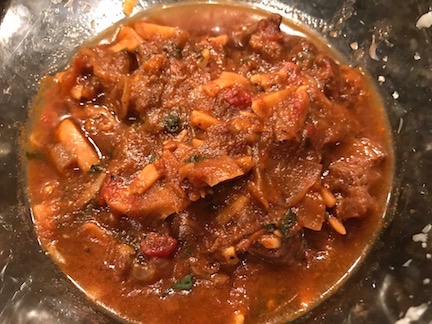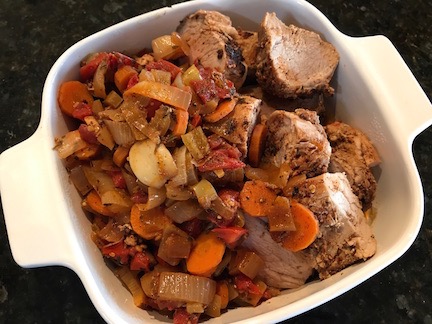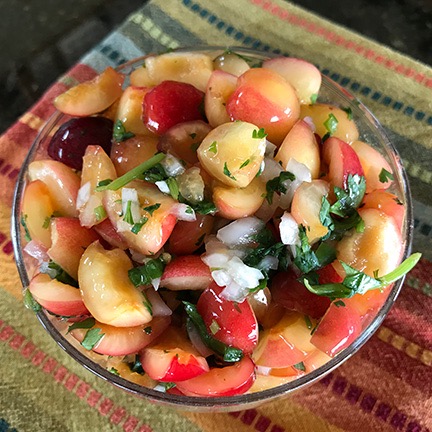My conversion of a slow cooker recipe for a pressure cooker.
I’m trying to do Whole30 these days. It was recommended by a friend late last summer and I hopped on in August. It was a huge change in my diet, mostly because I could no longer eat dairy and grains — and I’d been eating a ton of yogurt and granola for quite some time. But I came to feel that Whole 30’s emphasis on fresh lean meats and vegetables was good for me. It certainly makes me feel healthier.
Lots of folks complain about the amount of cooking you have to do with Whole30. I think that’s what I like best. I can make a batch of something and have leftovers for lunch. I especially love making a big batch of Paleo Moussaka, cutting it into single serving pieces, and freezing it in vacuum sealed packages for a quick and easy meal anytime I want it. And I like the challenge of taking a recipe that’s almost Whole30-compliant and modifying it to be fully compliant.
My friend Elizabeth loaned me a Whole30 cookbook and I browsed through it the other night looking for something new and interesting to make. I found a recipe for Slow Cooker Moroccan Chicken. I love the seasonings in middle-eastern and Moroccan foods so I figured I’d give it a try. But 6 hours in a slow-cooker? No thanks. I’ll make it in my instant pot.

My version of Moroccan Chicken, served on cauliflower “rice.” 30 minutes from an Instant Pot.
The recipe that follows was my first and very successful attempt. What threw me is that the original recipe did not call for any liquids to be added at all. I’ve never seen a slow cooker or pressure cooker recipe with no liquids, so I added about a half cup of coconut milk that was in my fridge, leftover from another meal I’d made earlier in the week. When I popped the lid on the Instant Pot, I was very surprised to see quite a bit of liquid in the pot, so I’m thinking that the coconut milk listed here isn’t necessary. I’ll leave it out next time.
Ingredients
Seasonings:
- 1/2 cup fresh cilantro
- 2 tbsp extra-virgin olive oil
- 2 tsp minced garlic. (I’ll admit it; I used it from a jar.)
- 2 tsp minced ginger. (I just happened to buy some frozen cubes of ginger earlier in the day and I used that.)
- 2 tsp paprika
- 1 tsp salt
- 1 tsp cinnamon
- 1/2 tsp turmeric
- 1/2 tsp ground cumin
- 1/2 tsp ground cardamon
Other ingredients:
- 1 large onion, chopped
- 1-1/2 pounds of boneless, skinless chicken thighs
- 1 large sweet potato, peeled and cut into 1-inch cubes
- 5 dates, pitted and sliced or chopped. (In a pinch, you could use the equivalent amount of raisins or prunes instead, but dates are best.)
- 1/4 to 1/2 cup coconut milk. (This is optional. See my note above.)
- 1/2 cup chopped fresh cilantro
- 1/2 cup sliced or slivered almonds, toasted. (I used sliced and did not toast them.)
Instructions
- Combine the seasoning ingredients in a small food processor or blender and process or blend until smooth. The result will be a paste.
- Put the onions into the bottom of the Instant Pot’s inner pot.
- Poke the chicken all over with a fork and then rub the seasoning paste into them, reserving about 2 tablespoons of the paste. Put the chicken on top of the onions. (I made sure I spread open the thigh pieces so they would cook thoroughly.)
- Coat the sweet potatoes with the rest of the seasoning paste. Put them in the pan on top of the chicken.
- Sprinkle the dates on top of the sweet potatoes.
- If using coconut milk, pour it as evenly as possible over the contents in the pot.
- Lock the pot. Press Manual and set the timer for 10 minutes.
- Allow the pressure to release naturally for 15 minutes. Open the pot carefully.
- Garnish with cilantro and almonds.
You can serve this over cooked cauliflower “rice,” other steamed vegetables (zucchini “noodles” are good for this), or real rice if you’re not following Whole30. The flavor is amazing.


 Now I know what you’re saying.
Now I know what you’re saying. 
